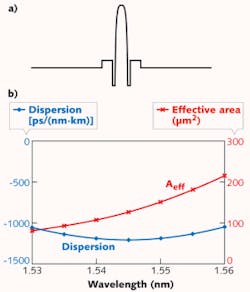FEW-MODED FIBER: Dispersion-compensating fibers show 4X+ improvement

Scientists at OFS Denmark (Brøndby, Denmark) and OFS Labs (Somerset, NJ) have developed a dispersion-compensating optical fiber with a factor of 5.0 improvement in figure of merit and a factor of 4.5 improvement in effective area compared to other state-of-the-art fibers.1 Using this fiber for dispersion compensation on a coherent communications network significantly reduces the energy consumption and complexity of the digital-signal processing (DSP) chip otherwise needed to perform full electronic/digital dispersion compensation. The large improvements in figure of merit and effective area reduce fiber nonlinearities and losses to the low levels needed when compensating for large amounts of dispersion in a coherent system.
‘Few-moded’ fiber design
The loss figure of merit (FOM) for a dispersion-compensating fiber (DCF) is defined as the dispersion coefficient DDCF divided by the attenuation coefficient of the DCF, αDCF. To date, the highest FOM reported is about 450 ps/(nm*dB). To increase FOM and allow for the highest possible effective area (the quantitative measurement of the transverse area covered by the mode transmitted through the fiber), the scientists used a few-moded fiber design with a germanium oxide (GeO2)-doped core, a fluoride-doped depressed cladding, another GeO2-doped surrounding ring, and finally the pure-silica outer cladding (see figure).
Unlike singlemode fibers, few-moded fibers transmit a small number of modes but are not considered true multimode fibers. Although these fibers do have a large effective area that minimizes nonlinear effects at high transmission powers, multipath interference (MPI) effects do need to be taken into account. Furthermore, DDCF and the effective area are increased by using the LP02 mode rather than the fundamental LP01 mode as the propagation mode. To convert between LP01 and LP02 modes, long-period fiber grating (LPG) fiber sections were spliced to the input and output of the DCF section of fiber. A bridge fiber (with a mode-field diameter matching that of the LP01 mode of the DCF) spliced in at both ends of the LPG input/output to the 2.1-km-long section of DCF completes the device. Insertion loss for the assembled DCF module is 3.1 dB at 1540 nm and 4.4 dB at 1550 nm, and the fiber attenuation value is 0.58 dB/km at 1550 nm as measured by an optical time-domain reflectometer.
Measurements of the DCF show a dispersion value of -1275 ps/(nm*km) and a FOM of 2200 ps/(nm*dB)—a factor-of-five improvement in FOM compared to existing fiber designs. In addition, the measured 90 µm2 effective area for this DCF is roughly 4.5 times larger than existing fibers, with a low MPI of -37 dB. The performance metrics for this fiber result in a DCF module that can compensate for the chromatic dispersion of a 1000-km-long singlemode fiber—roughly 17,000 ps/nm total—with an insertion loss of 10 dB.
Bera Pálsdóttir, manager for the incubation center at OFS Denmark, says, “Dispersion-compensating fibers are a proven, totally passive technology for the 10 and 40 Gbit/s transmission systems of today. Together with new requirements from coherent 100 Gbit/s transmission systems, the few-moded fiber technology has enabled the development of this DCF where both loss and nonlinear penalties are significantly reduced. We believe this new DCF can enable large energy savings in the coherent 100 Gbit/s transmission systems of tomorrow.”
REFERENCE
1. L. Grüner-Nielsen et al., OFC/NFOEC 2011, Los Angeles, CA, paper OWA1 (Mar. 9, 2011).

Gail Overton | Senior Editor (2004-2020)
Gail has more than 30 years of engineering, marketing, product management, and editorial experience in the photonics and optical communications industry. Before joining the staff at Laser Focus World in 2004, she held many product management and product marketing roles in the fiber-optics industry, most notably at Hughes (El Segundo, CA), GTE Labs (Waltham, MA), Corning (Corning, NY), Photon Kinetics (Beaverton, OR), and Newport Corporation (Irvine, CA). During her marketing career, Gail published articles in WDM Solutions and Sensors magazine and traveled internationally to conduct product and sales training. Gail received her BS degree in physics, with an emphasis in optics, from San Diego State University in San Diego, CA in May 1986.